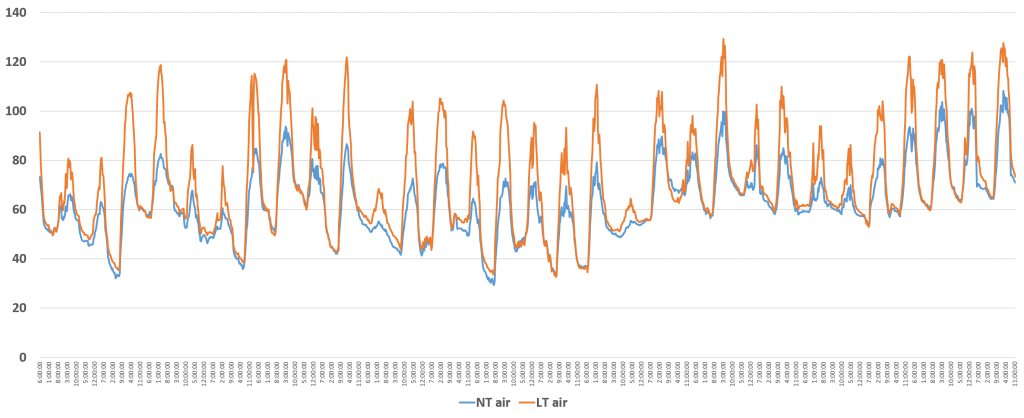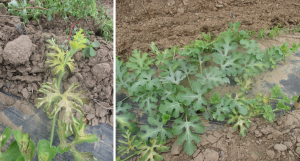Watermelon is best grown at temperatures around 80-90°F. Temperatures above 90°F reduce the growth rate; above 105°F may cause plant injury. Temperatures below 42°F result in watermelon chilling injury; below 32°F will kill watermelon plants. Extended cool days that lead to soil temperatures dropping into lower 50°F can also kill watermelon seedlings.
Using low tunnels is one strategy to avoid chilling injury and encourage early plant growth. How does the plastic covered low tunnels modify temperatures in early watermelon season? Figure 1 shows the air temperature comparison between low tunnel (1 mil plastic film, perforated) and without low tunnels. The data was taken from April 24 to May 25, 2020 in a watermelon field at Southwest Purdue Agricultural Center.

Figure 1. Air temperatures with (red line) and without (blue line) low tunnels from April 24 to May 25, 2020.
During the time period, the recorded minimal temperatures were below 40°F for 5 nights. Low tunnels increased the minimal temperature from 0-4.5 degrees (Table 1).
Table 1. Minimal air temperatures with and without low tunnels.
| Date | Apr. 27 | May 1 | May 9 | May 11 | May 12 |
| Without Low Tunnel | 32 | 35.8 | 29.3 | 32.9 | 34.5 |
| Low tunnel | 35.7 | 38.5 | 33.8 | 32.9 | 36.3 |
Low tunnels dramatically increased maximal air temperatures. The difference on maximal temperatures range from 10-35 degrees. During this one month period, there were 17 days with maximal air temperatures below 80°F, but only three days that the maximal air temperature did not reach 80°F under low tunnels. Maximal air temperatures reached above 120°F under low tunnels when air temperature were above 90°F.
How did the temperature differences affect watermelons? With the five very cold nights, not surprisingly, 95% watermelon plants were dead without low tunnels. While the death rate was only slightly better under low tunnels (77%).
Watermelon plants grafted onto squash rootstock survived the extremely cold night. Low tunnels made a big difference in their growth. Under the low tunnels, the vines were about 3 feet long after the first month. While the vines were just starting to grow without low tunnels (about 1 foot long).
Heat injury was observed on plants under low tunnels. The tip of the vines were yellow in addition to necrosis leaves (Figure 2). It is clear that plants were stressed under low tunnels that made the temperatures climb above 120°F on this Memorial Day weekend. Plants recovered after low tunnels were removed, yellowing leaves became necrosis, and new growing tips look healthy.
Figure 2. Heat injury on watermelon plants. Left: tip of the vines is yellowing right after low tunnels were removed. Right: plants recovered after a few days low tunnels have been removed.
Take home message: Using low tunnels for early watermelon planting can be a gamble. Low tunnels can make a huge difference if environmental conditions are perfectly right. That is to say on most of the days, high temperatures should be lower than 80°F, but cannot be too low to kill seedlings. Meanwhile, temperatures should not be above 90°F, otherwise the low tunnels may cause negative impacts on plant growth.
